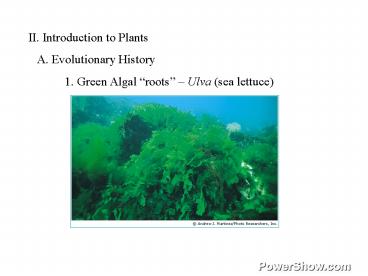II. Introduction to Plants - PowerPoint PPT Presentation
Title:
II. Introduction to Plants
Description:
II. Introduction to Plants. A. Evolutionary History. 1. Green Algal 'roots' Ulva (sea lettuce) ... a. Liverworts most primitive plants - lie flat on ground ... – PowerPoint PPT presentation
Number of Views:312
Avg rating:3.0/5.0
Title: II. Introduction to Plants
1
II. Introduction to Plants A. Evolutionary
History 1. Green Algal roots Ulva (sea
lettuce)
2
II. Introduction to Plants A. Evolutionary
History 1. Green Algal roots Ulva (sea
lettuce)
3
II. Introduction to Plants A. Evolutionary
History 1. Green Algal roots Ulva (sea
lettuce) 2. Colonization of Land Environmental
Diffs Aquatic Habitats Terrestrial Water
available Desiccating
4
II. Introduction to Plants A. Evolutionary
History 1. Green Algal roots Ulva (sea
lettuce) 2. Colonization of Land Environmental
Diffs Aquatic Habitats Terrestrial Water
available Desiccating Sunlight
absorbed Sunlight available
5
II. Introduction to Plants A. Evolutionary
History 1. Green Algal roots Ulva (sea
lettuce) 2. Colonization of Land Environmental
Diffs Aquatic Habitats Terrestrial Water
available Desiccating Sunlight
absorbed Sunlight available Nutrients at
Depth Nutrients available
6
II. Introduction to Plants A. Evolutionary
History 1. Green Algal roots Ulva (sea
lettuce) 2. Colonization of Land Environmental
Diffs Aquatic Habitats Terrestrial Water
available Desiccating Sunlight
absorbed Sunlight available Nutrients at
Depth Nutrients available Buoyant Less
Supportive
7
II. Introduction to Plants A. Evolutionary
History 1. Green Algal roots Ulva (sea
lettuce) 2. Colonization of Land Environmental
Diffs Aquatic Habitats Terrestrial Water
available Desiccating Sunlight
absorbed Sunlight available Nutrients at
Depth Nutrients available Buoyant Less
Supportive Low oxygen, higher CO2 reverse
8
II. Introduction to Plants A. Evolutionary
History 1. Green Algal roots Ulva (sea
lettuce) 2. Colonization of Land Environmental
Diffs B. Adaptations to Life on Land 1. Waxy
Cuticle (reduce water loss)
9
II. Introduction to Plants A. Evolutionary
History 1. Green Algal roots Ulva (sea
lettuce) 2. Colonization of Land Environmental
Diffs B. Adaptations to Life on Land 1. Waxy
Cuticle (reduce water loss) 2. Gametes protected
10
II. Introduction to Plants A. Evolutionary
History 1. Green Algal roots Ulva (sea
lettuce) 2. Colonization of Land Environmental
Diffs B. Adaptations to Life on Land 1. Waxy
Cuticle (reduce water loss) 2. Gametes
protected 3. Embryo protected
11
II. Introduction to Plants A. Evolutionary
History 1. Green Algal roots Ulva (sea
lettuce) 2. Colonization of Land Environmental
Diffs B. Adaptations to Life on Land 1. Waxy
Cuticle (reduce water loss) 2. Gametes
protected 3. Embryo protected VULNERABLE 4.
Spore wall thick
12
II. Introduction to Plants A. Evolutionary
History 1. Green Algal roots Ulva (sea
lettuce) 2. Colonization of Land Environmental
Diffs B. Adaptations to Life on Land 1. Waxy
Cuticle (reduce water loss) 2. Gametes
protected 3. Embryo protected VULNERABLE 4.
Spore wall thick 5. Support
13
II. Introduction to Plants A. Evolutionary
History B. Adaptations to Life on Land C.
Plant Evolution Acquisition of Terrestriality
14
III. Plant Diversity A. Non-tracheophytes (no
true vascular tissue) 1. Characteristics a.
short (no vascular tissues)
15
III. Plant Diversity A. Non-tracheophytes (no
true vascular tissue) 1. Characteristics a.
short (no vascular tissues) b. limited to moist
habitats (swimming sperm)
16
III. Plant Diversity A. Non-tracheophytes (no
true vascular tissue) 1. Characteristics a.
short (no vascular tissues) b. limited to moist
habitats (swimming sperm) c. have cuticle
17
III. Plant Diversity A. Non-tracheophytes (no
true vascular tissue) 2. Diversity a.
Liverworts most primitive plants - lie
flat on ground - antheridia and archegonia
on surface
18
III. Plant Diversity A. Non-tracheophytes (no
true vascular tissue) 2. Diversity a.
Liverworts most primitive plants b. Mosses
19
(No Transcript)
20
III. Plant Diversity A. Non-tracheophytes (no
true vascular tissue) 2. Diversity a.
Liverworts most primitive plants b. Mosses
- have stomata regulate water loss -
grow from tip (apical) - antheridia and
archegonia at stalk tips
21
Archegonium
Antheridium
22
III. Plant Diversity A. Non-tracheophytes (no
true vascular tissue) 2. Diversity a.
Liverworts most primitive plants b. Mosses
- have stomata regulate water loss -
grow from tip (apical) - antheridia and
archegonia at stalk tips - swimming sperm
23
(No Transcript)
24
- III. Plant Diversity
- B. Tracheophyte Origins
- 1. The Rhyniophyta
- vascular system of phloem and xylem
25
- III. Plant Diversity
- B. Tracheophyte Origins
- 1. The Rhyniophyta
- Silurian 440 mya
- vascular system of phloem and xylem
- tracheids in sporophytes
- - water and nutrient distribution
26
Gymnosperms Angiosperms
27
- III. Plant Diversity
- B. Tracheophyte Origins
- 1. The Rhyniophyta
- vascular system of phloem and xylem
- tracheids in sporophytes
- - water and nutrient distribution
- - lignin and support
28
III. Plant Diversity B. Tracheophyte
Origins 4. Life History simple (primitive) -
Homospory
29
III. Plant Diversity C. Non-seed
Tracheophytes 1. Lycophytes (Club Mosses)
30
III. Plant Diversity C. Non-seed
Tracheophytes 1. Lycophytes - (Club Mosses) -
ancient dominated first forests 300-350
mya
Lepidodendron - 45m -Carboniferous
31
III. Plant Diversity C. Non-seed
Tracheophytes 1. Lycophytes - (Club Mosses) -
ancient dominated first forests 300-350 mya
- simple leaves
32
III. Plant Diversity C. Non-seed
Tracheophytes 1. Lycophytes - (Club Mosses) -
ancient dominated first forests 300-350 mya
- simple leaves - Dominant Sporophyte (with
stobili)
33
III. Plant Diversity C. Non-seed
Tracheophytes 1. Lycophytes - (Club Mosses)
34
III. Plant Diversity C. Non-seed
Tracheophytes 1. Ferns and their allies
35
III. Plant Diversity C. Non-seed
Tracheophytes 1. Ferns and their allies -
true complex leaves
36
III. Plant Diversity C. Non-seed
Tracheophytes 1. Ferns and their allies -
true complex leaves - true roots
37
III. Plant Diversity C. Non-seed
Tracheophytes 2. Ferns and their allies -
true complex leaves - true roots - also
ancient appearing 350 mya - dominant
sporophyte reduced gametophyte
38
Fern Life Cycle































